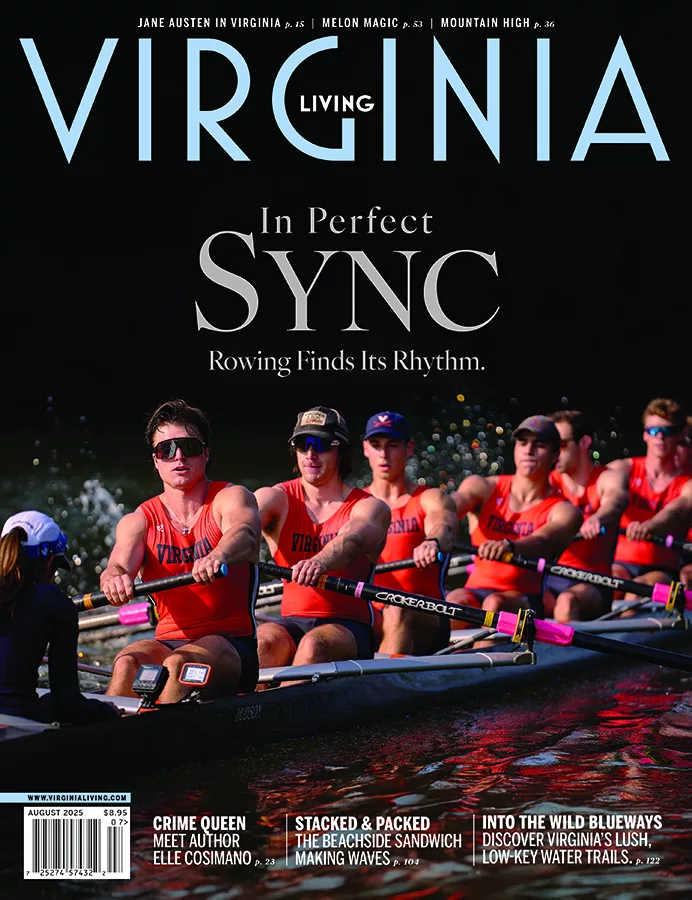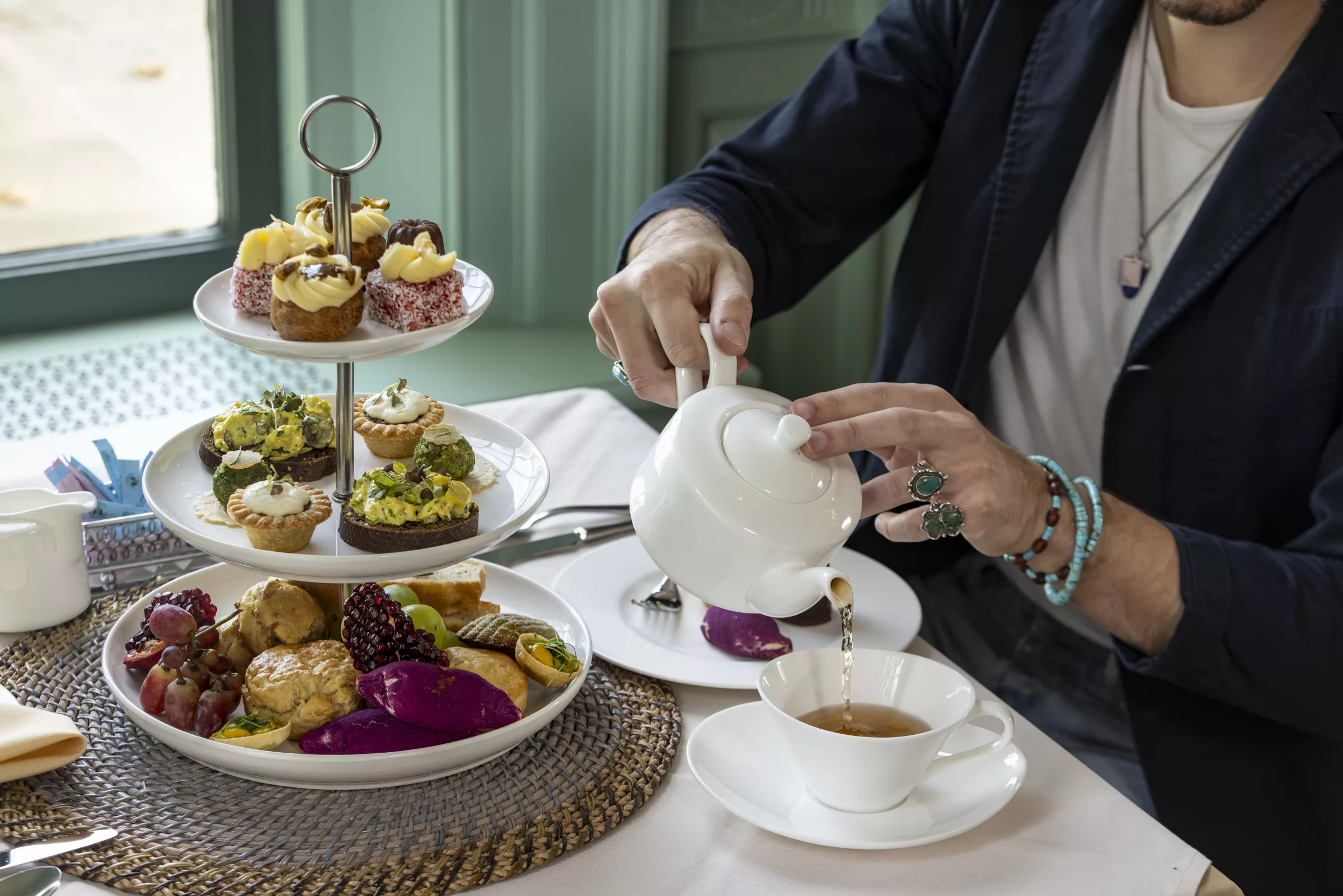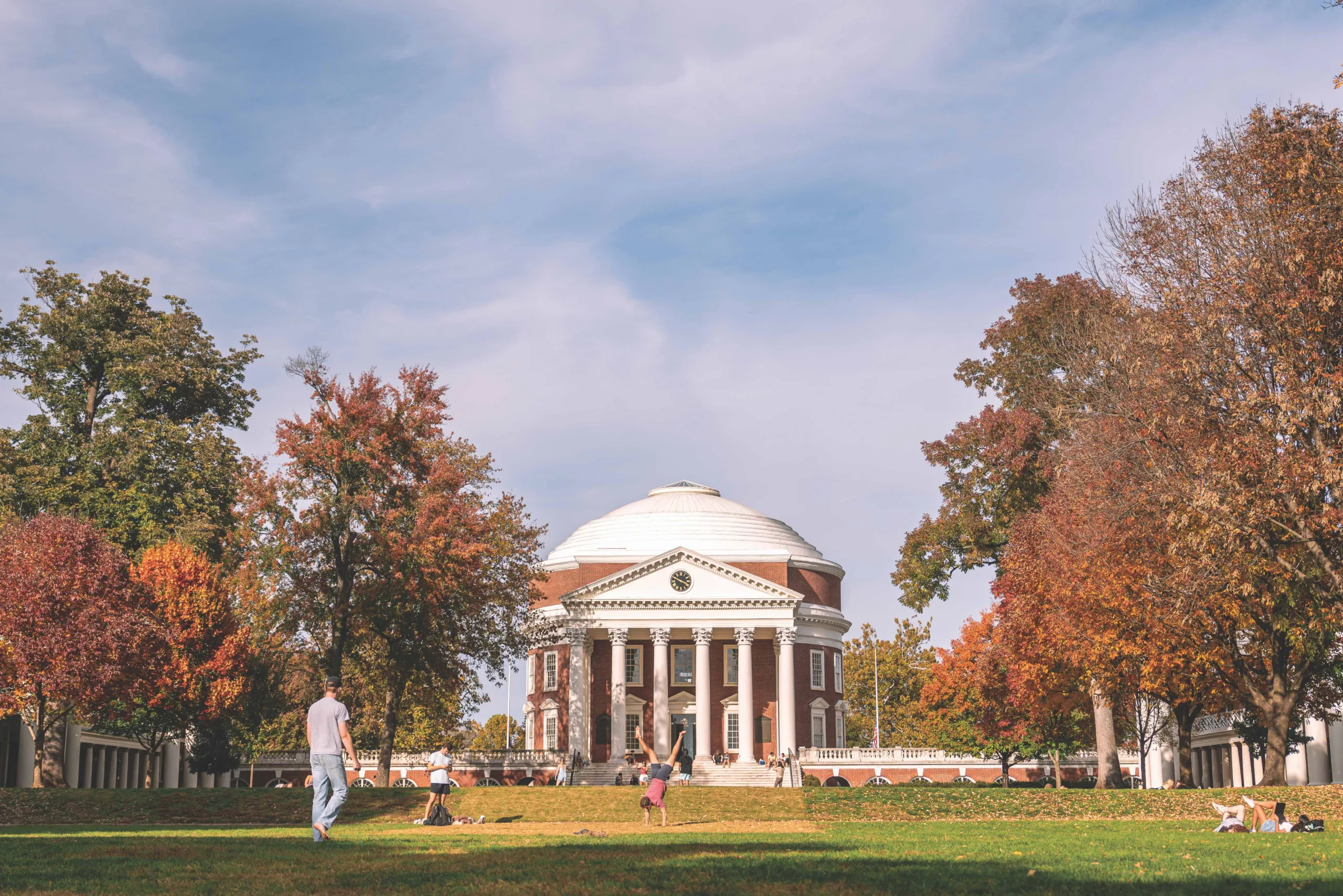With its $150 million renovation and expansion, the Virginia Museum of Fine Arts now has the wherewithal to, as one curator puts it, “surprise people with the treasures on view in their own backyard.”


Inside the VMFA’s expansive galleries.

From left, VMFA benefactors Harwood and Louise Cochrane and Frances and James McGlothlin.

VMFA director Alex Nyerges; Michael Brand, VMFA director 2000 – 2005.

Richard Woodward, VMFA’s curator for African art and its senior associate director for architecture and design, and Rick Mather, architect.

A vignette in the decorative arts exhibit; American art curator Sylvia Yount.
At long last, the newly expanded Virginia Museum of Fine Arts is swept clean of construction debris, its paintings are securely mounted on the walls, its art objects are spotlighted in the galleries, and its doors are thrown open to the public in a welcome that beats anything in its 74-year history. After five years of bulldozers and buzz saws and a 10-month hiatus, this treasure house on Richmond’s Boulevard re-opens on May 1 with a sparkling array of special exhibits, permanent galleries and social spaces.
The new Virginia Museum is huge. In fact, it’s now the 10th-largest comprehensive art museum in the country, with more than half-a-million square feet under roof, not to mention acres of outdoor sculpture gardens. “But it’s not size that’s important,” says Director Alexander Nyerges; “it’s quality. And the Virginia Museum has one of the finest art collections, not just in America, but in the world.”
Nyerges explains that before the 165,000-square-foot new wing was built, “we could display about 2,500 works of art in the galleries. Now there are more than 5,000 objects on display, many that people have never seen before. Our special exhibition space has doubled, which will allow us to accommodate the larger exhibitions we used to have to turn away. And we now have a spacious, convenient parking deck, a new library, two new restaurants and new children’s facilities. And …”—he pauses for emphasis—“we’re free!”
The design uses glass and light to blur the boundaries between indoors and out. No solid brick walls block the view; rather, curved glass defines the space and gives the building a feeling of transparency. No matter where you stand, you can see through a glass wall to something else—another indoor gallery or light-filled atrium, or outside to the sculpture garden that slopes gently along the length of the museum up to the top of the parking deck.
The idea for the expansion took shape in the mid-1990s. That’s when the Board of Trustees developed a strategic plan to deal with the museum’s main shortcoming: a lack of space for the permanent collection, for special exhibitions and for visitor parking. The original building, which opened on the Boulevard in 1936, had been enlarged four times over the years—most recently in 1985—yet the collection had outgrown even that space.
The $150 million project was far more complicated than simply attaching an addition to the existing building. It included a complete renovation of the structure as well as the updating of several antiquated systems such as fire suppression, lighting and security. “It was like a Rubik’s Cube times a thousand,” says Nyerges, who came to the museum in 2006 from the Dayton Art Institute, when the construction was already underway. Some will remember that when the expansion was first announced, it was scheduled for completion in 2007, in time for the 400th anniversary of the founding of Jamestown. “The complexity of the expansion made that impossible,” says Nyerges. “It was a renovation plus a retrofit plus new construction. I am thankful that we could do it all and be closed only 10 months.”
The complete project—new addition, 600-car parking deck and renovation of the original building—was financed with both public and private money. One-third of the funding was public; two-thirds, private. “Fifty million comes from the Commonwealth in the form of bond issues,” says Richard Woodward, who is both senior deputy director for architecture and design at the VMFA and also curator of African art. “The rest comes from individual donations—amounts ranging from $50 to $10 million. People really believed in the project.” Woodward explains that the Commonwealth pays for about half of the museum’s ongoing operating costs—salaries and utilities, for example—but “no tax money is ever involved in art purchases.” Art objects are either donated or are purchased with donated money.
The new construction includes several spaces named for their donors. They include the James W. and Frances G. McGlothlin Wing, containing thousands of feet of gallery space; the Louise B. and J. Harwood Cochrane Atrium, which connects the new and the old buildings and provides a window on the Boulevard; and the Mary Morton Parsons Plaza, which reorients the entrance toward the Boulevard. The Margaret R. and Robert M. Freeman Library (the largest fine arts and humanities library in the southeast, according to museum officials) and the E. Claiborne and Lora Robins Sculpture Garden round out the dedicated areas. The Best Café is a nod to Frances and the late Sydney Lewis, founders of Best Products, who donated their extensive collection of contemporary art, Art Nouveau and Art Deco furniture and other decorative objects to the museum.
The most stunning bit of architecture is the Cochrane Atrium, a soaring “main street” that beckons visitors and links the various wings with seven suspended walkways and two glass elevators—plus one enclosed elevator for the faint-hearted. A massive Egyptian statue looks out from the atrium’s second-story window, peering down on the people on the ground floor and up on those crossing the aerial bridges. The Cochrane Atrium is the heart of the museum, connecting galleries and amenities such as the museum shop, café, lounges, restaurant/bar, library and auditorium.
Harwood Cochrane, founder of Overnite Transportation, is not your typical art museum benefactor. He is not an art collector, so he did not have a houseful of paintings to donate. What Harwood and his wife, Louise, did have was money and a deep fondness for the Virginia Museum, and it was they who went knocking on the museum’s door, offering help, and not the other way around. “We were looking for some way to make a difference,” Harwood Cochrane explains during a recent visit to the museum. The couple has donned hard hats as they make their way slowly through the construction site. “All my life, I’d been buying trucks and tires and things that wear out and lose their value. Then I realized that art goes up in value every year. Art will be here forever. And art is for everybody—young and old, rich and poor, black and white.”
In the 1980s, the Cochranes contacted the museum. “We asked some questions,” says Hardwood Cochrane. “I liked what I heard. The museum serves everyone—that’s an important factor to us.” After discussing the museum’s needs with David Bradley, the Foundation’s vice president for finance and administration, the Cochranes donated $1 million. “David asked us if there was any particular place we wanted the money to go. We said no. He said the museum would appreciate some more American art. That suited us just fine. Then we took a second look.”
That second look led the Cochranes to do more—to create, in 1988, an endowment to support the museum’s American art collection. While its value fluctuates with the market, the American art endowment is said to be worth around $100 million today.
The Cochranes did not donate their money in the usual manner. In the 1980s, according to museum officials, the trucking magnate and his wife opted to give the institution property to be sold. They donated Walnut Hill, the 460-acre estate in Hanover County where they had lived for 51 years, along with an assembled group of warehouses in Shockoe Slip and 44 acres in Manchester (on the south side of the James River). The VMFA Foundation coordinated the sales and plowed all proceeds into the endowment.
The endowment’s principal is not touched. The interest, about $1.5 million a year, pays curators’ salaries and is used to purchase American art—more than 30 important pieces over the last 20 years, including works by Thomas Hart Benton, William Merritt Chase and James McNeill Whistler. Most of the acquisitions have been paintings, but there is also a Tiffany screen, a Philadelphia side chair, and Harwood’s favorite, a marble sculpture of Cleopatra by William Wetmore Story.
Cochrane’s fortune came from the sale of Overnite Transportation, a company he founded in 1933 with two beat-up trucks that hauled hay and fertilizer. In the days when virtually all freight traveled by rail and most roads were unpaved, this Goochland native pioneered the use of trucks for hauling goods. Overnite did not grow overnight, but it did expand steadily over the decades until Cochrane sold the company in 1986 for $1.2 billion. Today, at 97, Cochrane’s focus is on philanthropy. “I’m going to give it all away,” he says, “if I live long enough.”
His wife, Louise, is an artist who’s been painting for decades. Drawn to the museum in the 1970s, she became a volunteer, working at the information desk twice a month and occasionally giving gallery tours. Undeterred by age—Louise is 93—or macular degeneration, she still paints, usually flowers, landscapes and seascapes. “No portraits,” she says firmly. “Too many people to please.” How does she manage when she is partially blind? “I can’t refine things anymore, but someone lines up the paints for me, and I know where everything is. I’m in good company, you know,” she adds with a smile. “Monet, Cezanne and Georgia O’Keeffe had the same problem.”
“The Cochrane endowment makes us the envy of other museums,” says Sylvia Yount, the curator of American art, who works closely with the Cochranes. Most museums either have very limited acquisition funds or are largely dependent upon donated art objects, which inevitably leaves a collection fairly static or lopsided. The Virginia Museum has the luxury of using endowed funds to purchase art to fill in the gaps and to build on strengths. The result is a wide-ranging collection of American art, one that Yount rates among the best in the country. “The Cochranes are not collectors themselves,” she says. “They are collecting for the Commonwealth. Of course, we consult with them before buying anything, and we wouldn’t pursue a work if Louise and Harwood weren’t in favor of it.”
“Well, now,” smiles Harwood Cochrane. “Sylvia is a right good salesman.”
The Cochrane endowment has had wide-reaching ramifications, according to Yount. “It catapulted this regional American art collection to a national spotlight,” says the curator. “Moreover, their commitment helped inspire others to donate their collections—the McGlothlins, for example.”
The McGlothlin Collection, assembled in the past 15 years by James W. and Frances G. McGlothlin of Bristol, features work by American masters of the late 19th and early 20th centuries, including George Bellows, Mary Cassatt, Childe Hassam, Robert Henri, Winslow Homer, John Singer Sargent and James McNeill Whistler. The McGlothlins’ relationship with the Virginia Museum developed along with their collection, beginning with Fran’s service on the Board of Trustees, followed by the loan of paintings for a special exhibit in 2005, a donation of $30 million for the new wing and, ultimately, the bequest of the bulk of their collection, valued at more than $100 million, to the museum. They continue to acquire actively, but now, as Jim McGlothlin told Yount, “We keep in mind how a particular piece would mesh with artworks already in the museum’s collection.”
Michael Brand no longer works for the Virginia Museum, but he explains, “This expansion was the main focus of my life for five years.” Brand, who was the museum’s director from 2000-2005 before leaving to join the Getty Museum, selected the architect for the new wing, oversaw architectural drawings and raised most of the money in a major capital campaign. “Construction had just begun when I left Richmond for the Getty,” says Brand, “so I only wore a hard hat once.”
Asked how the expansion will alter the Virginia Museum, Brand pauses. “There are three [benefits], really. For one thing, it repositions the museum in the art world. The museum will get more attention for its justifiably famous collection, which, for the first time, will be available in its entirety. Also, a building that has been expanded four times [creates] confusion. The demolition of the 1976 wing and the additions and improvements unify the whole and create a sophisticated, integrated campus. And, finally, the addition of great architecture is a tremendous benefit to any city.”
The project’s architect was the London-based firm Rick Mather + SNBW Architects. It was picked partly because the company has considerable experience with museum expansions and public building design, although this was the first American commission for the American-born Rick Mather. A working museum is hugely complicated because it incorporates so many different types of space and functions almost like a miniature city. There are exhibition galleries, of course, but also business offices, libraries, restaurants and cafés, bars, kitchens, mechanical plants, parking decks, retail shops, classrooms, storage spaces, gardens, meeting rooms, theaters, conservation laboratories and workshops, each with its own design paradigm. “The Virginia Museum is fairly unique in belonging to the Commonwealth of Virginia,” says Mather, “but for any public building, it should be clear that it’s not a private club. Everything about the design—the building, entrances, plaza, sculpture garden—has been organized to create an invitation to enter the site.”
John E. Buchanan Jr., director of the Fine Arts Museums of San Francisco, has maintained a steady interest in the Virginia Museum since his friendship with the late Leslie Cheek, who was the VMFA director from 1948-1968. Buchanan’s two art museums recently completed major expansions, so he speaks with the voice of experience when he says that the new addition in Richmond will allow the Virginia Museum to “enlarge its circle of family and friends and lay the foundation for the next generation of art supporters.” He is enthusiastic about Rick Mather’s design, which he has seen in the construction phase, and looks forward to a repeat visit this spring. “The plans could not have been any better,” says Buchanan. “They provide an appropriate showcase, a home that steps up to the quality and significance of the art collection. Alex and the trustees and staff have a marvelous vision to reach broadly and deeply into the population of Virginia and the Eastern seaboard, inviting people into the museum in ways that were not possible before.”
As Yount, the curator of American art, puts it, the Virginia Museum is “a genuinely democratic space, and free to all. It is an extraordinary legacy that ultimately belongs to all Virginians. Many people are going to be surprised when they see the treasures on view in their own backyard.”
Art museums have been fighting the elitist image for decades. On May 1, the Virginia Museum hopes to banish the impression forever with its engaging exhibits, inviting atmosphere and captivating new space. Says architect Rick Mather, “The message is, ‘Welcome, please come in.’” Many, many visitors are expected to accept the implied invitation—and do just that.
Raising the Bar
An Interview with Sylvia Yount, the VMFA’s Curator of American Art
It was the best of times and the worst of times when the Virginia Museum went searching for a new head of their American art department in 2006. While the Cochrane endowment and the McGlothlin bequest positioned the museum on the forefront of the country’s art collections, the museum was in the throes of a massive construction project. A new curator faced the daunting task of not only planning the reinstallation of the American collection in a brand new space, but also of organizing a special exhibition (titled “American Art from the McGlothlin Collection”) for the grand opening in 2010.
Sylvia Yount, a native of New York’s Hudson River Valley who holds a Ph.D. in art history from the University of Pennsylvania, seemed tailor-made for the job of curator of American art. She had spent six years at the High Museum of Art in Atlanta and eight years at Philadelphia’s Pennsylvania Academy of the Fine Arts, where she had curated many exhibitions, organized two collection reinstallations, and published and lectured widely on American art and culture. She spoke to Mary Theobald recently about her career, her VMFA job and American art. Excerpts:
How did an Italian major from New York University become interested in American art history?
During my senior year, I lived and studied in Urbino, the small Renaissance hill town where Raphael was born. That experience inspired me to pursue art history over language—something about being immersed in that artistic setting, I guess. Soon after, I began working at the Isabella Stewart Gardner Museum in Boston, where I became fascinated with their lesser-known American art collection. Plus, in practical terms, there seemed to be greater opportunities to make a contribution to American art scholarship than to the more entrenched field of Italian Renaissance. I’m confident I made the right choice.
You’ve had experience teaching at the University of Pennsylvania. What made you become a curator rather than a professor?
Because my formal introduction to art history came about more through museum collections than academic studies, I’ve always been devoted to working with objects. I feel strongly that museums offer distinctive teaching opportunities, even if one isn’t directly aware of the public audience.
You oversee an impressive collection of American art. How does the VMFA collection stack up to others?
I think it’s fair to say that when we open the new McGlothlin Wing, with its expanded suite of American art galleries, VMFA will establish a higher profile as one of the choicest collections of American art on the eastern seaboard. Recent acquisitions like the remarkable Worsham-Rockefeller Aesthetic Movement period room in and of itself will become a destination for visitors, just like our Lewis Collection of Decorative Art, Ganz silver, and Fabergé material. Moreover, our generous Cochrane endowment for the purchase of American art is the envy of many curatorial colleagues at larger institutions. The future definitely looks bright.
Who are the hottest historical American artists today?
Based on recent auction results, there are three styles of painting that continue to set records—Hudson River School, American impressionism, and the so-called Ashcan school of early-20th-century realists. While these artists will surely hold their own in the decades ahead, we’re seeing growing interest in women artists and artists of color as well as lesser-known modernists. I’m happy to say that VMFA is attuned to all of these developments and, in some instances, well ahead of the curve.
If you could wave your magic wand and add any piece of art in the world to the VMFA American art collection, which would it be?
Oh, that’s a tough one, but as a paintings person and given what we’re lacking, I’d have to say an iconic Winslow Homer oil produced during his post-Civil War stay in Virginia—for example, the compelling A Visit from the Old Mistress, which the Smithsonian American Art Museum is lucky to call its own. Another personal Homer favorite is Summer Night at the Musée d’Orsay, in Paris—I dream about that painting.
What, if anything, do you collect?
I used to be a bit of a record collector in my DJ-ing college days, but now my efforts are wholly directed to collecting American art for Virginia and beyond.
Have you ever broken anything?
Perish the thought!
What are your favorite and least favorite American objects on display in the VMFA collection?
That’s probably the hardest question for any curator to answer, but let me say there are two paintings that continue to captivate me and, honestly, take my breath away each time I lay eyes on them: Sargent’s Mrs. Albert Vickers, a little-known but highly significant portrait from the artist’s early English sojourn, and Hopper’s House at Dusk. Both of these haunting images will have pride of place in our new American galleries, where I hope visitors will become better acquainted with their special qualities.
As for my least favorite, I’ll carry that nugget to my grave—or at least to deep storage, where the work will remain!









